
UTTRI associates postdoctoral fellow Dr. Willem Klumpenhouwer and Professor Matti Siemiatycki comment on demand-responsive transit (DRT) in a recent Globe and Mail article about the Town of Cochrane’s experience.
The Town of Cochrane, Alberta (population 34,000) did not have a public transit system before 2019 when it implemented Cochrane On-Demand Local Transit (COLT), which allows riders to book rides through a smartphone app or by telephone.
One of the primary benefits of operating demand-responsive transit in lower-density areas is cost savings over operating a fixed-route transit system.

In the article, Klumpenhouwer discusses the costs and benefits of DRT services and the number operating across Canada.
“The balancing act, says Klumpenhouwer, is providing an affordable service that is convenient enough to convince people to stop driving to work.”
DRT benefits a community by offering a convenient, cheaper and more environmentally-friendly alternative to driving. But overall benefits are hard to document, says Klumpenhouwer.
“Klumpenhouwer says . . . it is virtually impossible to prove a correlation between increased use of mass transit and a reduction in vehicle accidents or a rise in population health.”

Siemiatycki notes that “pooling” transportation services, like DRT, have the downside of increasing user wait times.
“Siemiatycki says that while DRT may have a role to play in public transit, it will never fully replace the fixed-route system, especially on heavily used routes.”
Researchers and planners generally agree that fixed-route transit systems are a more efficient option for densely populated areas.
Read “Alberta town’s COLT vehicles show the potential of ‘demand-responsive transit,’” Globe and Mail, May 6, 2021. [paywall]
Related content
- We’re still learning about demand-responsive transit, says Klumpenhouwer
- The new age of on-demand transit in Canada: Klumpenhouwer
- Klumpenhouwer, Willem, “The State of Demand-Responsive Transit in Canada: Final Report,” prepared by the Transit Analytics Lab with support from Mitacs and the Ontario Society of Professional Engineers, July 2020
